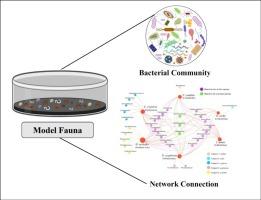Soil mesofauna bacterial diversity: Insights from cultured collembolans, enchytraeids, and mites species
IF 1.5
4区 环境科学与生态学
Q2 BIODIVERSITY CONSERVATION
引用次数: 0
Abstract
Soil fauna-associated microbial communities play crucial roles in nutrient cycling, host health, and ecosystem functioning. However, the differences and connections among microbiota of different soil fauna species under identical cultivation conditions remain poorly understood. Our study characterized bacterial communities of six soil fauna species (the collembolans Folsomia candida, Isotomiella minor and Onychiurus yodai; the enchytraeus Enchytraeus crypticus; the oribatid mite Damaeus expinosus and the predatory mite Hypoaspis aculeifer) after three years of standardized cultivation using 16S rRNA gene high-throughput sequencing. Results revealed distinct microbial community patterns across species. Proteobacteria dominated F. candida (78.4 % relative abundance), while Bacteroidetes were most abundant in I. minor (76.1 %), and Acidobacteria comprised 88.4 % of O. yodai's microbiota. The predatory mite H. aculeifer harbored twice the microbial diversity of detritivorous species like F. candida, reflecting their trophic position as generalist feeders within soil food webs. Only 0.8 % of OTUs (125 out of 36,719) were shared across all species, with H. aculeifer harboring the most unique OTUs (3143). Co-occurrence network analysis showed predominantly positive microbial interactions, suggesting cooperative relationships within host-associated communities. Our study demonstrates that soil fauna harbor highly specialized microbiota shaped by host ecology and trophic level, even under uniform environmental conditions. These findings provide new insights into soil biodiversity and highlight the potential of fauna-associated microbes as bioindicators for ecosystem health assessment.

土壤中游动物细菌多样性:从培养的线虫、内生虫和螨虫物种的见解
土壤动物相关微生物群落在养分循环、宿主健康和生态系统功能中起着至关重要的作用。然而,在相同的栽培条件下,不同土壤动物物种微生物群之间的差异和联系尚不清楚。本研究采用16S rRNA基因高通量测序技术,对经过3年标准化培养的6种土壤动物(collebolans Folsomia candida、Isotomiella minor和Onychiurus yodai, enchytraeus crypticus,恙螨Damaeus expinosus和掠食性螨Hypoaspis aculeifer)进行了细菌群落特征分析。结果显示不同物种的微生物群落模式不同。假丝酵母菌中以变形菌门为主(相对丰度为78.4%),拟杆菌门最多(相对丰度为76.1%),酸杆菌门占O. yodai菌群的88.4%。掠食性螨(H. aculeifer)的微生物多样性是念珠菌(F. candida)等食性螨的两倍,反映了它们在土壤食物网中的营养地位。只有0.8%的otu(36,719个中有125个)在所有物种中共享,其中H. aculeifer拥有最独特的otu(3143个)。共现网络分析显示,微生物相互作用主要是积极的,表明宿主相关群落之间存在合作关系。我们的研究表明,即使在均匀的环境条件下,土壤动物也具有由宿主生态和营养水平形成的高度专业化的微生物群。这些发现为土壤生物多样性提供了新的见解,并突出了动物相关微生物作为生态系统健康评估生物指标的潜力。
本文章由计算机程序翻译,如有差异,请以英文原文为准。
求助全文
约1分钟内获得全文
求助全文

 求助内容:
求助内容: 应助结果提醒方式:
应助结果提醒方式:


